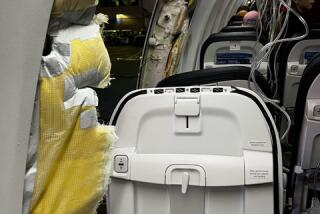His heroics happened not in the air but at a hamburger stand

Unlike some flight attendants, I’ve never swung open the door of a disabled aircraft and directed an evacuation. I’ve never rushed to the aid of shrieking passengers after the cabin pressure dropped precipitously.
I’ve never wrestled a shoe-bomber, performed CPR on a toddler, fought a raging galley fire or used a defibrillator to shock a passenger back to life.
During my 30-year career, in which I worked thousands of flights to more destinations than I can remember, no airline passenger placed his or her life directly in my hands.
Instead, my moment of reckoning came 30,000 feet below cruising altitude — in the food court at Chicago’s O’Hare Airport.
Dressed in civilian clothes and traveling on an airline employee pass, I dragged my roll-aboard toward the departure gate for a flight to Miami. Along the way, I stopped at McDonald’s to grab a bite.
I stood at the food court counter, unwrapping my feast while watching the traveling hordes scamper through the terminal.
At first, the coughing sound was barely noticeable. I assumed one of the many diners seated behind me was clearing his or her throat. But soon, the coughing intensified. As I sank my teeth into the burger, I felt a sudden nudge in my back. I turned around. Swallowed hard. Stared in disbelief.
A woman, perhaps 40, stood facing me. She began jabbing both index fingers at her throat as if acting out a comic pantomime. Her mouth opened in a silent scream. Her eyes grew wide. A raspy groan escaped.
I watched in astonishment as her face turned a sickly shade of blue.
The woman obviously had a piece of food lodged in her throat. If her airway remained blocked, she could die.
Someone grabbed her by the waist and spun her around. He seemed to know how to help. It took a moment, but I realized that someone was me.
Every year, flight attendants take part in the Federal Aviation Administration’s mandated recurrent training when we practice aircraft evacuation drills, study safety protocols and rehearse on-board medical scenarios. We’re taught to treat symptoms rather than diagnose illness.
When someone is choking, gesturing toward the throat, wheezing and turning blue, we’re told to use the Heimlich maneuver, a procedure named for Dr. Henry Heimlich, who first detailed it in 1974.
It requires a rescuer to stand behind the choking victim and apply a series of quick upward thrusts to the person’s diaphragm. This movement compresses the lungs, causing a rush of air to dislodge (it’s hoped) the object and reopen the airway.
As I stood behind the choking victim in the food court, I interlocked my fingers and placed my folded hands just below her diaphragm. I applied one quick upward thrust, then another.
Under the watchful eyes of airline instructors, I practiced this maneuver once a year for nearly 30 years. But those exercises involved rubber training dummies. This was a human being.
After the third upward thrust, the object remained lodged in her throat. The crowd of onlookers had grown considerably. I didn’t focus on faces, but I could feel the stares and hear the gasps, and I shared their trepidation.
By now they were looking at a woman in real trouble. Her head hung limply and her arms dangled at her sides. She let loose a wheezy groan. I felt the weight of her body as she began to lose consciousness.
The Heimlich maneuver wasn’t working. Or maybe, after all these years of practicing on rubber dummies, I wasn’t properly performing the maneuver. I adjusted my hand placement and gave a fourth upward thrust to the diaphragm.
Ta-da!
To my amazement — and to the apparent surprise of onlookers who scrambled to avoid the soggy projectile that arced high in the air and landed a few feet away — out popped an enormous crouton. The woman had been eating a salad, and perhaps, in a hurry to catch her flight, she was eating too fast.
She began to cough. Then whimper. But her breathing appeared normal. Someone escorted her to the restroom, where she could regroup.
Although I never saw her again, something unexpected happened at the scene. Witnesses began clapping and cheering. People shook my hand, patted my back, smiled. One woman had tears in her eyes. Truth be told, so did I.
Before ambling to the departure gate, I finished my burger, which had grown cold and rubbery.
It was the best burger I’ve ever had.
More to Read
Sign up for The Wild
We’ll help you find the best places to hike, bike and run, as well as the perfect silent spots for meditation and yoga.
You may occasionally receive promotional content from the Los Angeles Times.






